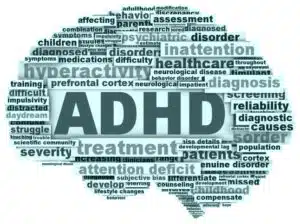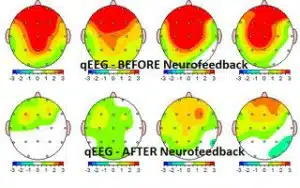Training your Brain

Imagine you are watching your favorite movie. Right now the character on screen is getting coffee with her friend and they are discussing their nightly plans. Your mind begins to wander away from the movie, your concentration dwindles and you began to space out. At this moment, all of a sudden, the movie on screen becomes blurry and the sound stops playing as loud.
This is just the reminder you need to concentrate again and to focus your efforts on paying attention to the movie. As the movie progresses, this continues to happen: when your brain is under stimulated and your mind wanders, the movie stops and when you pay attention again, the movie starts. This reward system, over time, slowly trains people with ADHD to sharpen their concentration and sustain attentiveness. What I have just described is an example of Neurofeedback: Training your brain to reduce the symptoms of ADHD.
How does Neurofeedback work?
In a Neurofeedback session, a practitioner “maps” out a patients brain. Before a session begins, a patient puts on a cap and has electrodes attached to his or head. In Neurofeedback sessions, participants can be playing a video game, watching a movie or listening to song. The game, song or movie only continues when the participant is utilizing the correct portion of their brain to focus or else the task stops.
During the task, a color coded map appears on the computer screen and shows the practitioner where there is too much or to little brain wave activity. The goal of Neurofeedback is to use this brain training exercise to reduce the ADHD symptoms of impulsively and inattentiveness. The feedback provided during the treatment session can be lowering the volume or providing poorer picture resolution of the onscreen task.
Only a healthy brain wave pattern can make the picture resolution clearer and the volume louder. Over the course of the program, the brain learns this feed back system. The computer program compares the EEG reading of the ADHD participants brain waves with the database of typical human brain wave patterns (matching for age and sex).
What if I am already taking medication and see a therapist? Could Neurofeedback back help me?
Neurofeedback therapy can reduce the amount of medication a person with ADHD needs. Some clinicians say that Neurofeedback needs to be used in combination with medication because it has not been tested as much as medication has been. However, there are those who propose to utilize Neurofeedback instead of medication because of the side effects associated with medication (loss of appetite, sleep issues etc.).
How many sessions of Neurofeedback are necessary?
A typical session of Neurofeedback ranges between 10- 30 minutes. A typical range of sessions is about 20-40 sessions with 2-3 sessions per week. Before participants engage in Neurofeedback they first need a medical evaluation, neuropsychological testing, to fill out their symptom questionnaire and then have an EEG measure their brain wave/ strength.
Neurofeedback at the Sachs Center!
Neurofeedback works directly with the problem as ADHD is a brain problem first and foremost. A the Sachs Center, participants will be able to “train” their brain to focus more, be less impulsive and they will be able to take control of their behavior. Also, Neurofeedback is an enjoyable treatment option especially for children.
https://www.youtube.com/watch?v=CJjuC8wG8OM
Work Cited:
www.additudemag.com/neurofeedback-adhd-brain-training/
www.aboutneurofeedback.com/conditions/adhd/
https://www.hullinstitute.com/neurofeedback.aspx
https://www.neurocorecenters.com/what-is-neurofeedback/
Arns, M., Heinrich, H., & Strehl, U. (2014). Evaluation of neurofeedback in ADHD: the long and winding road. Biological psychology, 95, 108-115.
https://www.quietmindfdn.org/node/78